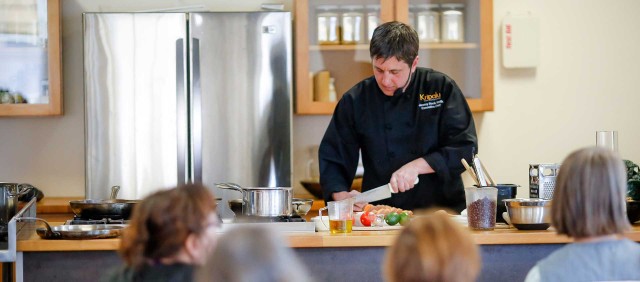6 Tips for Home Cooking from the Kripalu Kitchen

Before I came to Kripalu, I took a few years off from cooking professionally, and that time turned out to be invaluable—because I had the opportunity to take all my commercial experience and apply it to making healthy meals at home. I learned what works when translated to the home kitchen, and what doesn’t. I figured out time-saving shortcuts, ways to plan meals for a busy week, and how to make dishes that appeal to a variety of palates (including those belonging to toddlers).
That experience, along with what I hear from guests who come to my Kripalu programs, helped me understand some of the most common roadblocks that home cooks face. Here’s my advice for dissolving those self-imposed obstacles and getting more comfortable in the kitchen.
Don’t expect too much of yourself. Your family is not going to judge you if you don’t cook a three-course meal every night—or ever. To take the pressure off, try filling their plates with one special thing and two really good things, rather than three elaborate components. For example, chicken with adobo spice and an avocado puree as the centerpiece, and simple rice and beans, cooked with nothing but olive oil and salt, on the side.
When you have time, cook for cooking’s sake. Find a day once a week, or every couple of weeks, to cook as a learning experience, rather than cooking just to eat. Go for a new, more complicated recipe, or experiment with an ingredient you’ve never worked with before. You’ll gain confidence and expand your repertoire.
You don’t need a ton of spices to make food taste good. People tend to think that you have to use a million exotic spices in order to make a dish flavorful. Actually, all you need is the right ingredient or two—usually stuff you already have on hand. It can be as simple as a sprinkle of cumin and a squeeze of lime on a sweet potato, and the whole flavor changes.
All you really needs is one good knife. My favorite style of knife is a small vegetable cleaver, otherwise known as a Santoku. Okay, it also helps to have a couple of bamboo spoons, a spatula, a few cast iron or stainless steel pots, and a baking dish or two. But you don’t need all kinds of fancy, specialized implements in order to cook well. What they mostly do is make more dirty dishes.
Make meals that are easy to modify. If you’ve got a range of preferences or eating styles in the family, you don’t need to make half a dozen different meals. Instead, focus on the vegetable- and grain-based side dishes—they’re usually user-friendly for everyone. If you’re cooking for a mix of vegetarians and meat-eaters, make one flavorful sauce and two protein choices (say, shrimp and tofu) to go under it. Making mac-and-cheese? Split the cheese sauce in half and mix one half with sautéed chard and chipotle. Divide the cooked pasta in two pans, pour the two sauces over each, and you’ve got kid and adult versions.
Think of recipes as guidelines, not laws. Do it once according to the instructions and, if you like it, toy with it next time so you like it even better. Recipes will get you 85 percent of the way to a great dish, but the rest is all about your personal preferences. Make it yours!
Jeremy Rock Smith, Kripalu faculty and a graduate of the Culinary Institute of America, began his career in classical French cuisine.
Full Bio and Programs